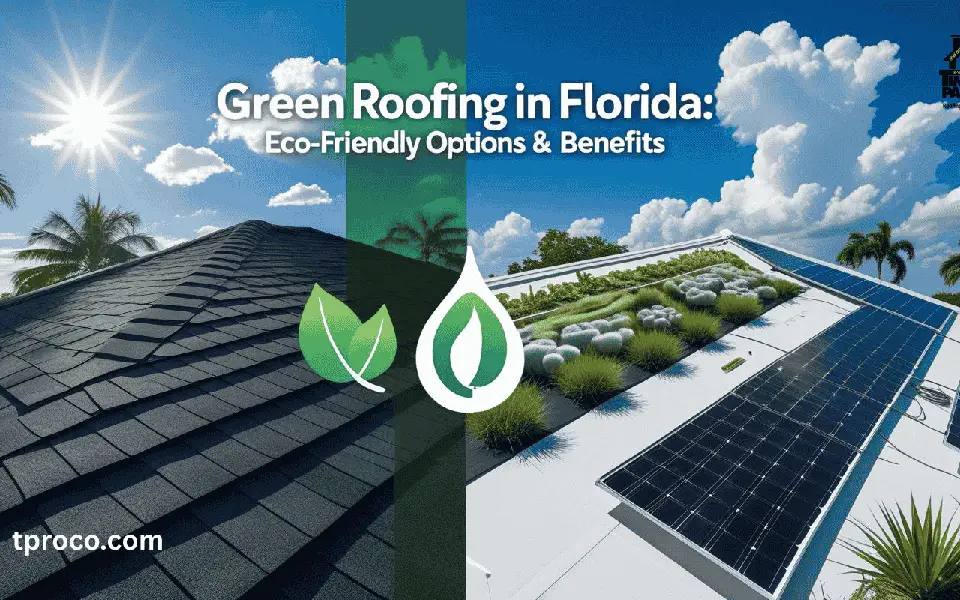Our Blogs
Florida Roof Inspections: Know When & Why to Call a Pro 🔎
Florida sees a unique mix of scorching sun, rapid storms, and hurricane threats, all of which can stress and degrade a roof quickly. Yet many homeowners only think about their roof when a serious leak or visible damage appears. A regular pro roof inspection can catch subtle cracks, wind-lifted shingles, or code compliance issues long before you face soaked drywall or a total re-roof. This blog delves into why and when to schedule professional roof checks in Florida’s environment—covering everything from insurance incentives to storm readiness. Whether you’re a new homeowner or you’ve lived under the same shingles for decades, a timely inspection keeps surprises (and repair bills) at bay, ensuring your roof can withstand Florida’s worst.

1. The Critical Role of Roof Inspections in Florida
While roof checks matter everywhere, Florida raises the stakes with:
- Hurricane Wind-Uplift: A small loosened shingle can rip away under 100+ mph gusts, exposing the underlayment or deck. An inspection identifies and reseals these vulnerabilities pre-storm.
- UV-Driven Aging: Asphalt shingles or membrane surfaces break down faster under relentless sunlight. Inspectors spot hairline cracks, curling edges, or granule loss before major damage.
- Frequent Heavy Rain: A tiny gap around a vent flashing can become a significant leak during Florida’s torrential downpours. Regular checks keep flashing sealed.
- Coastal Salt Air: Coastal homes face faster corrosion of metal fasteners or drip edges. Inspectors note rusted nails or compromised flashing that might otherwise go unnoticed.
Given how quickly small issues can balloon, skipping routine inspections is risky. A single unspotted nail pop might cause a slow attic drip that fosters mold in Florida’s humid environment. Then, by the time you see a ceiling stain, the deck might be rotted. Inspections bring peace of mind by ensuring your roof is storm-ready, leak-free, and aligned with Florida’s evolving codes.
2. When to Schedule a Professional Inspection
Florida homeowners often ask, “How frequently should I check my roof?” Key intervals include:
Biannual (Spring/Fall):
Inspect after winter’s dryness and before hurricane season picks up in June, then again in the fall post-hurricane or heavy rains. This schedule helps you catch any damage inflicted by recent storms.
Post-Storm Checks:
If a named storm or intense thunderstorm passes, a targeted inspection ensures no wind-lifted shingles or cracked tiles. Insurance claims often hinge on documented post-storm findings.
Prior to Insurance Renewal:
Florida insurers sometimes demand updated roof condition reports. A pro check can confirm your roof’s compliance or reveal minor fixes that keep your premium stable.
Before Listing/Selling a Home:
A pre-listing inspection can prevent buyer negotiations or last-minute requests. It also reassures potential buyers that the roof is solid, crucial in Florida’s real estate market where roof age is a big factor.
Even if you don’t follow a strict schedule, you should definitely call an inspector if you notice water stains, missing shingles, or sudden spikes in AC bills (possibly from compromised attic ventilation). Florida’s climate changes quickly, so a “wait and see” approach is risky—a small problem might be a big leak in waiting.
3. What a Florida Roof Inspection Typically Covers
A legitimate professional inspection is more than a quick look. Expect:
- Visual Surface Check: Inspectors look for missing shingles, loose flashing, rust on metal parts, cracked tiles, or obvious water ponding on flat roofs.
- Underlayment & Deck Probing: They might lift a shingle corner or check attic access (if available) for deck or underlayment condition. In Florida, verifying peel-and-stick membranes or older felt is crucial.
- Flashing & Penetration Seals: Skylights, vents, chimneys—each potential leak point is examined. For tile roofs, inspectors check mortar or foam adhesives, ensuring wind-uplift compliance.
- Gutter & Drainage Flow: Clogged gutters, if left unnoticed, lead to water backing up under eaves, especially under Florida’s intense rain events.
- Structural Signs: Any sagging ridges or cracked rafters? While not always part of a basic roof check, many inspectors at least note suspicious dips.
They’ll also evaluate your roof’s approximate remaining lifespan, crucial for deciding if repairs suffice or if a re-roof is near. Florida’s building code or local ordinances might come into play if significant portions need replacement. A thorough report includes photos highlighting trouble spots and recommended next steps—like “replace missing ridge cap,” “reseal flashing,” or “monitor next 12 months.” This level of detail helps Florida homeowners budget and plan effectively.
4. DIY vs. Professional Inspections
DIY roof checks can catch obvious issues—like a missing shingle or big hole. But Florida’s environment demands deeper scrutiny:
- Trained Eye for Subtle Damage: A pro sees small hail bruises or wind-lifted tabs that the untrained eye dismisses. Florida storms can create hairline cracks invisible from ground level.
- Attic Evaluations: Inspectors often peek inside your attic for water stains, mold, or deck rot. Florida’s humidity can hide slow leaks you’d never spot from outside.
- Safety & Code Expertise: Climbing a roof under Florida’s sun or potential slick surfaces is hazardous. Pros use harnesses and know the local code. They recognize if certain repairs meet wind-uplift rules or if a partial re-roof triggers the 25% rule.
A quick homeowner glance from ground level helps you notice big red flags. But for a real handle on your roof’s condition, especially if you suspect storm damage or your roof is older than 7–10 years, a professional is invaluable. Florida insurers or realtors typically trust licensed inspectors over a homeowner’s personal guess, particularly in potential claims or transactions.
5. Insurance & Real Estate Benefits of a Pro Check
A pro roof inspection often yields direct financial perks in Florida:
Insurance Discounts or Hassle-Free Renewals:
Many Florida insurers ask for roof condition reports when your policy renews, especially if your roof is over 10–15 years old. A documented pro report confirming good condition might stave off premium hikes.
Storm Damage Claims:
If your inspection finds wind or hail damage, having a contractor’s written assessment plus photos can expedite claims. Florida insurers sometimes demand proof damage is storm-related, not old wear.
Real Estate Transactions:
Buyers in Florida worry about the roof’s age and shape. A recent inspection showing 5–10 years of life left can secure stronger offers. Conversely, if the report reveals hidden issues, you can fix them or disclose them properly.
A small investment in an annual or biannual inspection pays off by avoiding last-minute claim rejections (“pre-existing condition”) or failing a buyer’s mortgage requirement if the roof is questionable. For Florida property owners, the roof is an essential protective asset—keeping it documented and up to code fosters big peace of mind (and potentially some insurance savings).
6. Post-Inspection Follow-Up & Common Fixes
After your pro inspector delivers the report:
Review Repair Recommendations:
Maybe you need new vent flashing, re-attaching a few loose shingles, or cleaning debris from valleys. These smaller fixes cost less if done soon, rather than letting them escalate.
Budget for Major Repairs or Re-Roofing:
If the inspector sees significant hail hits or indicates only 2–3 years of life left, start saving or discussing financing for a future re-roof. Florida’s climate can accelerate that timeframe if big storms strike.
Compare Contractor Quotes:
Ask a reputable Florida roofer for estimates on recommended repairs. If your inspection was done by a different contractor, try to get a second quote to confirm fairness.
Monitor for Changes:
If the inspector said, “Tiny crack in tile, no immediate leak but keep an eye on it,” do a brief visual check every couple of months or after a big storm. Keep up with small tasks like re-caulking if they mentioned potential problem areas.
Florida’s code demands thoroughness. Even if your recommended fix is modest, ensure the roofer uses code-compliant nails, underlayment patches, or adhesives. Then keep the inspection report and receipts for your records—handy if you need proof for insurers or potential buyers that the roof is well-maintained.
Conclusion
Scheduling regular roof inspections in Florida is more than a formality—it’s a protective measure against the sun, storms, and code pitfalls unique to the Sunshine State. Rather than waiting for water stains or a wind-ripped section, a pro’s detailed check highlights subtle issues early: popped nails, compromised seals, or beginning deck rot. That knowledge prevents pricey repairs later, plus it strengthens your position with insurers or realtors if you plan to renew a policy or sell your property. In a climate where a small crack turns big leak fast, consistent inspections and quick action keep your roof strong and your wallet happier. Don’t let hidden damage linger—call a trusted Florida roofing inspector today for peace of mind overhead.
Frequently Asked Questions (FAQ)
🔎 Is Your Florida Roof Ready for the Next Storm Season?
Don’t wait for a leak to find out. Professional inspections uncover hidden issues like wind-lifted shingles, cracked seals, and code problems—before they become expensive disasters.
#tproco #tppro #tprci #urro #rrfl
#RoofInspection #FloridaHome #StormReady #TampaCheckup #OrlandoRoofCare #SunshineState
Schedule a Free InspectionAbout the Author

Timothy Parks
CEO
📢 Stay Informed: Communication & Consent Updates
At Timothy Parks Roofing & Construction Inc., we prioritize transparency in our communications. By submitting a request, you agree to receive calls, texts, and emails regarding our services. Standard messaging rates may apply. You can opt-out at any time by replying STOP or contacting us directly.
✅ Florida License: #CBCO59592, #CCC1327217, #HI4878
📌 Privacy & Terms: Read our Privacy Policy and Terms of Service.



